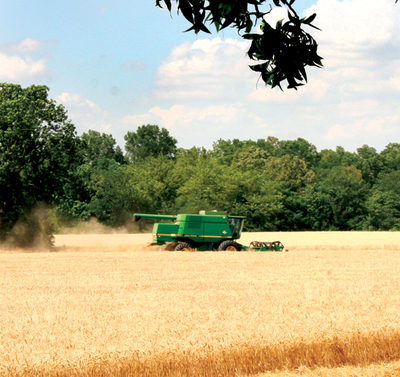
Agriculture's good times: Will they continue in 2014?
“It’s no secret farming expenses are going up, and if the USDA analysts are right, we could be facing a little squeeze," Mississippi Land Bank Chairman of the Board Abbott Myers said at the organization's annual meeting. "On the other hand, the USDA and prognosticators aren’t always right."

While agriculture has enjoyed “some really good times in the past few years,” Mississippi Land Bank Chairman of the Board Abbott Myers says the USDA is projecting that farm income will decline in 2014 “and there could be some bumps in the road ahead.
“Everyone knows things in agriculture tend to cycle up and down,” the Dundee, Miss., producer said at the organization’s annual meeting. “Anybody who’s been in farming for any length of time knows hard times will come sooner or later.
“It’s no secret farming expenses are going up, and if the USDA analysts are right, we could be facing a little squeeze. On the other hand, the USDA and prognosticators aren’t always right.
“All is not doom and gloom,” Myers told the organization’s stockholders and staff. “Eighty percent of the world’s population is moving into the middle class at a rapid pace, and developing countries will be the engine of our growth in the future.

THE U.S. is still the breadbasket of the world, says Mississippi Land Bank Board Chairman Abbott Myers. and "developing countries will be the engine for growth in the future."
“That middle class worldwide will demand better food, clothes, better products, and we in the U.S. need to be prepared for this. We’re still the breadbasket for the world.”
Competition is increasing from South America, India, western Russia, and other countries, Myers says. “They’re pushing their production, and we’re going to need to be more efficient in agriculture, more productive.
“We have a big advantage over Brazil, Argentina, and other countries, but a lot of our ports need to be modernized, and we need to invest more in our future, particularly our transportation infrastructure, including the Upper Mississippi River system.”
AG NEWS delivered daily to your inbox: Subscribe to Delta Farm Press Daily
A question mark for the economy in the period ahead, Myers says, is what the Federal Reserve will do in setting interest rates. “Whenever the Fed stops pumping money into the market, as it has been doing for many months, interest rates are going to go up, and the stock market likely will go down.
“It’s interesting that some of the higher-rated companies in the U.S. are now in the bond market raising capital. Are they doing this for future growth and expansion, or are they preparing for bad times? Whatever affects the economy also affects agriculture. And whatever the future brings, we must be prepared for the unexpected.”
Land price outlook hard to discern
His most-asked question, Myers says, is “What are farm land prices going to do?

TIM HESTER, left, and Travis Satterfield, right, both at Benoit, Miss., visit with James Robison, Guntown, Miss., at the Land Bank meeting.
“I don’t think we’re going to see a farm land bubble, as some were predicting a year and a half ago. I do think we’re going to see some softening of land prices. However, sales in this region have been very few, and it’s hard to see a definite trend one way or another.
“Farm land prices have risen some since our meeting a year ago, but right now they seem stable, or maybe decreasing slightly. We hear of big sales to investment funds or other outside buyers, but it’s the average sale price that indicates what land prices are doing — and we just haven’t had enough sales to determine a trend.”
Production and commodity prices are going to be a major determinant in what land prices do, Myers says.
“The USDA says rice prices for 2013 will be down 12 percent, corn down 22 percent, beans down 14 percent, and cotton down 4 percent. Cattle prices are high now, and timber prices are still pretty much waiting on recovery in the economy and in housing.
“Returns for crops will determine how much land rent we pay, and return on crops and the rent we pay will be a factor in farm land prices.“
Factors that affect commodity prices will be an important influence on the farm economy and land prices, he says. “Demand is one of those influences. After the USDA said corn prices would go down, they did go down, but they’ve come back above $5 because of strong export demand. Soybean demand is also strong.”
Energy costs can also have a significant impact on the ag economy, Myers says.
“The U.S. has good supplies of oil and gas, but currently three refineries are shut down, which is affecting prices. There have been no new refineries built in this country in a long time, and the lack of refining capacity is really going to cause a crunch in fuel prices short-term.”
While the stock market has had a significant increase since last year’s meeting and unemployment figures are down, “the number of people not looking for work is increasing,” he says. “It doesn’t make a lot of sense when 50 percent of our nation isn’t working and the unemployment rate goes down. Whatever the numbers, unemployment is too high — and this needs to be corrected.”
The Environmental Protection Agency “has been very busy, pumping out new rules and regulations,” Myers says, “and we will need to continue to be vigilant to protect agriculture from burdensome regulations.”
Farm bill implementation still murky
On the legislative front, he says, “The good news is, we have a farm bill. The bad news is, we don’t really know what’s in it, or how some of the provisions will be implemented.
“Anybody who farms needs to be very careful in the decisions they make with this new legislation. In some cases, it’s going to be a challenge to try and outguess the government and outguess the markets at the same time.

ROBERT MASSEY, from left, Senatobia, Miss.; Alan Blaine, Starkville, Miss.; and Ronnie Jones, Holly Springs, Miss., await the start of the Land Bank annual meeting.
SEE VIDEO: Under new farm bill, expect to manage risk more on your own
“And the farm bill fight isn’t over yet — it’s ongoing. Right now, some in Congress are trying put a limit on the crop insurance provisions.”
Political conflicts can be a major influence on markets, particularly exports, Myers says. “Ukraine is a really important agricultural region — they’re just beginning to adopt modern machinery, seed, and advanced technologies. They grew a tremendous corn crop last year. But their political situation is anything but stable, and we don’t know how it’s going to play out in terms of the role as a competitor.
“Probably the greatest impact on our markets is the biggest unknown — weather. Weather gave us great yields last year, but with the cold, rainy weather we’ve had, many of us are already behind in planting this year’s crops, and who knows what harvest will bring?”
Farm bill support tools and calculators can be found here: http://bit.ly/P3x0FR
In their report on Mississippi Land Bank performance for the past year, Myers and the organization’s president, Gary Gaines, said growth continued “at an impressive rate,” topping the $500 million mark.
“After a record-breaking year in 2012, we bettered that in 2013,” Gaines says. “Our net volume was $131.7 million, which increased our loan volume to almost $530 million outstanding at year end — a 5.5 percent net increase for the year, quite an accomplishment.
“We had three branches with over $100 million in loan volume outstanding. Three years ago, we didn’t have any branches at $100 million. This reflects a tremendous effort from our staff. And credit quality, at 99 percent, continues to be top-notch. I’d stack that up against any financial institution today.”
Net interest income remained strong in 2013, with strong patronage dividends,” Gaines says. “Our assets continued to grow, as did our loan volume and member equity. Our permanent capital ratio was strong at 15.34 percent. This will allow us to weather potential difficult times in agriculture and continue to provide credit in good times as well as bad.”
Last year, Myers says, patronage dividends returned to stockholders totaled $1.8 million. “Over the last four years, Mississippi Land Bank has given back $6.7 million to stockholders. No one else in agricultural lending does this except Farm Credit institutions, and MLB is pleased to be a part of that system.
“We had a great year in 2013 — we grew at 5.5 percent. While that may not sound like a lot, last year was unusual. It was a great crop year, many farmers did quite well, and a lot of our borrowers paid off loans or paid down loans.
“That’s great — lenders always like to have loans paid off. They like for farmers to prosper. But that means we have to go out and make more loans to keep our volume up. So, a 5.5 percent growth rate in a really good farming year like 2013 is outstanding.”
About the Author(s)
You May Also Like



